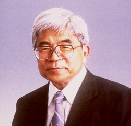
Name: Dr. Shoichi Noguchi (President of Sendai Foundation for Applied Information Sciences)
Title of talk: Semantics and Semantic Communication
Abstract:
Short Abstract: In this talk, first the basic concept of semantics and semantic communication is discussed. The quality of the semantics of an object is decided by the level of the information, it is concerned with, is contained. A hierarchical four-layer model is introduced to explain the level of information content. The first of the four layers represent the formal information, which is represented by a series of symbols. The second layer is the common information which is widely recognized as the common knowledge among the community. The third layer consists of knowledge information and the emotional information. On the basis of this third layer information, most of our daily social activities are accomplished. Information at the fourth layer is recognized as the highest level of information for human activities. This abstract information contains the philosophical truth, the spirituality in religious beliefs and the emotion involved with a work of art. This model is closely related to the philosophy of the Buddhism.
The organization of the information contents of an individual is achieved through the communication among individuals in a community. This means that the semantics is increased by semantic communication within community. At the same time, it is very important to mention that the contents obtained by the communication between two objects, A and B, is decided by the level of the common semantics which both A and B share between each other. From this communication it is evident that there does not exist a perfect semantic communication on the third and the fourth layers of semantics defined above. Under such a communication environment, it becomes very important to find a supporting method which would improve the imperfect semantic communication among the objects. For the third layer semantic communication, several important supporting methods are proposed. Among them, communication supported by the metaphor and the ontology technologies are explained. There is no fundamental idea to improve semantic communication on the fourth layer. But, we must recognize that there are so many important results which deeply enrich our human life by the heuristic semantic communication on this fourth layer. Many results involving communication in this layer are explained.
Short biography
After receiving Doctor of Engineering Degree from Tohoku University, Japan, in 1961, Dr. Shoichi Noguchi dedicated his research to the field of computer science, computer systems and computer networks. Dr. Noguchi served as Professor of Tohoku University (1971~1993), Director of Computing Center of Tohoku University (1984~1990), Director of Research Center for applied Information Science (1990~1993), Professor of Nihon University (1993~1997), President of Information Processing Society of Japan (1995~1997), President of the University of Aizu (1997~2001), and President of Sendai Foundation for Applied Information (1990 till date). Dr. Noguchiˇ¦s three significant contributions in research are (1) Establishment of a theoretical background for algebraic and cellular automata theory which focuses on characterization and unification of automata by algebraic theory and proof of completeness of one dimensional cellular automata; (2) Development of a large-scale parametron computer named Sendai Automatic Computer 1 (SENAC-1) which was the largest computer in Japan during late 1950s. It was jointly developed by Tohoku University and NEC Corporation. Its advanced concepts on architecture design was and still been widely applied to today's computers; and (3) Theoretical analysis of the concept of time-sharing and space-sharing systems which was the first of its kind in the world of computer systems.
In addition to research, Dr. Noguchi played an important role in developing computer networks in Japan. From 1985, serving as the head of the Tohoku University Large Computer Center, Prof. Noguchi promoted the research and development of computer networks mainly with the members of large computer centers at the top seven national universities in Japan. In addition, he planned and completed Tohoku University Academic/All-round/Advanced Information Network System (TAINS). This was the first large-scale academic network in Japan. Dr. Noguchi promoted many research projects financed by the Ministry of Education, Japan. These projects include Japan Academic Inter-University Network (JAIN), and they contributed greatly to the progress in research on networks, and to promote internet, in Japan.